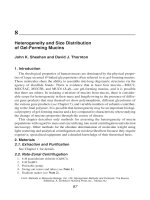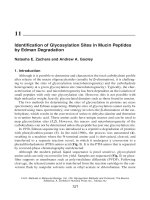Glycoprotein methods protocols - biotechnology 048-9-075-085.pdf
Bạn đang xem bản rút gọn của tài liệu. Xem và tải ngay bản đầy đủ của tài liệu tại đây (142.64 KB, 9 trang )
Separation and Identification of Mucin 77
7
Separation and Identification
of Mucins and Their Glycoforms
David J. Thornton, Nagma Khan, and John K. Sheehan
1. Introduction
This chapter describes a strategy for the separation and identification of the mucins
present in mucous secretions or from cell culture, focusing primarily on those mucins
involved in gel formation. At present, the mucins MUC2, MUC5AC, MUC5B, and
MUC6 are known to be gel-forming molecules (1–4). These mucins share common
features in that they are oligomeric in nature and consist of a variable number of mono-
mers (subunits) linked in an end-to-end fashion via the agency of disulfide bonds. In
addition, their polypeptides comprise regions of dense glycosylation interspersed with
“naked” cysteine-rich domains (4–7).
Histological and biochemical investigations suggested that mucous-producing tis-
sues and their secretions contained a complex mixture of mucin-type glycoproteins.
However, until recently and with the advent of the new mucin-specific probes arising
from cDNA cloning studies, this theory was not definitively proven. In situ hybridiza-
tion and Northern blotting studies have shown that more than one gel-forming MUC
gene product can be expressed in a single mucus-producing epithelia, i.e., MUC5AC
and MUC5B in the respiratory tract and MUC5AC and MUC6 in the stomach (4,8).
Subsequent biochemical studies on human airway mucus have shown that these two
mucin genes are not only expressed but that their glycosylated products are present in
respiratory tract secretions (2,3). A further more recent insight into the complex nature
of the mucin component of mucous has been the demonstration that a mucin gene
product from a single epithelium can have a different oligosaccharide decoration and
thus exist in what are termed glycoforms. For example, the MUC5B mucin in the res-
piratory tract can exist in two distinctly charged states (3). Thus, these studies demon-
strate the need to have techniques available to dissect these complex mixtures to
ascertain mucin type, amount, and glycoform. Such investigations may lead to the
identification of novel members of this growing family of molecules.
Owing to the extreme size and polydispersity (M
r
= 5–50 × 10
6
) of the gel-forming
mucins in particular, there are few separation techniques available to use with these
77
From:
Methods in Molecular Biology, Vol. 125: Glycoprotein Methods and Protocols: The Mucins
Edited by: A. Corfield © Humana Press Inc., Totowa, NJ
78 Thornton et al.
molecules. However, the smaller and more homogeneous reduced mucin monomers
generated after reduction (M
r
= 2–3 × 10
6
) are amenable to conventional biochemical
separation methods. We describe a separation protocol based on anion exchange chro-
matography to fractionate the different species of mucin coupled with agarose gel
electrophoresis as a method to measure their homogeneity. Identification of mucin
polypeptides is achieved by use of MUC-specific antisera and fragmentation followed
by amino acid compositional analysis and peptide purification and sequencing. Mucin
glycoforms are detected using carbohydrate-specific probes, i.e., lectins or monoclonal
antibodies. Figure 1 summarizes the overall procedure.
2. Materials
2.1. Extraction and Purification
See Chapter 1 for details.
Fig. 1. Outline of the protocol for separation and identification of mucins.
Separation and Identification of Mucin 79
2.2. Preparation of Reduced Mucin Subunits
1. Reduction buffer: 6 M guanidinium chloride, 0.1 M Tris-HCl, 5 mM EDTA, pH 8.0.
2. Dithiothreitol (DTT).
3. Iodoacetamide.
4. Buffer A: 6 M urea, 10 mM piperazine pH 5.0, containing 0.02% (w/v) CHAPS.
5. PD-10 (Amersham Pharmacia Biotech, St. Albans, UK) or equivalent desalting column.
2.3. Separation of Mucin
2.3.1. Anion-Exchange Chromatography
1. Mono Q HR5/5 column (Pharmacia).
2. Buffer A (see Subheading 2.2.).
3. 0.4 M lithium perchlorate.
2.3.2. Agarose Gel Electrophoresis
1. Horizontal electrophoresis apparatus, e.g., Bio-Rad DNA subcell Model 96 (25 × 15 cm
gels) and the Bio-Rad subcell (15 × 15 cm gels).
2. Agarose (ultrapure).
3. Electrophoresis buffer: 40 mM Tris-acetate, 1 mM EDTA, pH 8.0, containing 0.1% (w/v)
sodium dodecyl sulfate.
4. Loading buffer: electrophoresis buffer containing 30% (v/v) glycerol and 0.002% (w/v)
bromophenol blue.
5. Transfer buffer: 0.6 M NaCl, 60 mM sodium citrate.
2.4. Identification of Mucin
2.4.1. Tryptic Digestion
1. Digestion buffer: 0.1 M ammonium hydrogen carbonate, pH 8.0.
2. Modified trypsin or other proteinase.
2.4.2. Trypsic Peptide Analysis
1. Digestion buffer: 0.1 M ammonium hydrogen carbonate, pH 8.0.
2. Superose 12 (Pharmacia) or equivalent column.
3. µRPC C2/C18 PC 3.2/3 column (Pharmacia) or other C2/C18 column.
4. 0.1% (v/v) trifluoroacetic acid (TFA).
5. Acetonitrile.
2.4.3. Amino Acid Analysis
1. 6 M HCl.
2. Redrying buffer: ethanol:triethylamine:water (2:2:1 [v/v/v]).
3. Coupling buffer: ethanol:triethylamine:water:phenylisothiocyanate (PITC) (70:10:19:1
[v/v/v/v]).
4. 3µ ODS2 column (4.6 × 150 mm) (Phase Separations, Clwyd, UK).
5. Buffer A: 12 mM sodium phosphate, pH 6.4.
6. Buffer B: 24 mM sodium phosphate, pH 6.4, containing 60% (v/v) acetonitrile.
80 Thornton et al.
3. Methods
3.1. Extraction and Purification
For a detailed description of extraction and purification, see Chapter 1. In brief,
mucins are extracted from samples at 4°C with 6 M guanidinium chloride containing
proteinase inhibitors and are purified by isopycnic centrifugation in CsCl density gra-
dient first in 4 M guanidinium chloride (removal of proteins) and then in 0.2 M
guanidinium chloride (removal of nucleic acids). Finally, the preparation of mucin is
dialyzed into 4 M guanidinium chloride for storage.
3.2. Preparation of Reduced Mucin Subunits
Mucin subunits (monomers) are prepared by reduction and alkylation of purified
mucins as follows:
1. Transfer (by dialysis or dilution) the mucins into reduction buffer.
2. Reduce the mucins by the addition of DTT to a final concentration of 10 mM for 5 h at
37°C.
3. Alkylate the free-thiol groups generated by reduction with the addition of iodoacetamide
to a final concentration of 25 mM. This step can be performed overnight in the dark at
room temperature.
4. Transfer the reduced mucin subunits into buffer A by chromatography on a Pharmacia
PD-10 column (follow manufacturer’s instructions) or by dialysis.
3.3. Separation of Mucin
Separation of reduced mucin subunits is achieved by using anion-exchange chro-
matography on a Mono Q HR 5/5 column (Fig. 2A). Assessment of the effectiveness
of the separation is monitored with a periodic acid-Schiff (PAS) assay and with a
variety of lectins and mucin- or carbohydrate-specific antibodies (for a discussion of
the relative merits and drawbacks of these analytical tools, see Chapter 4). The homo-
geneity of the fractions is monitored by agarose gel electrophoresis and Western blots
of the gels can be probed with lectins and antibodies. Using this methodology, we
have shown that with pooling and rechromatography it is possible to prepare mucin
subunit samples enriched in specific MUC gene products and also to isolate different
glycosylated forms (glycoforms) of a single MUC gene product (see, e.g., refs.
2 and 3).
An example of the data obtained, using this methodology with a salivary mucin
reduced subunit preparation, is shown in Fig. 2. The range of charge density of the
molecules (Fig. 2a) is typical of that observed for the reduced subunits prepared from
the gel-forming mucins isolated from other epithelial secretions (respiratory and cer-
vical) and from intestinal cell lines (HT-29 and PC/AA). In this example the electro-
phoretic mobility of the reduced subunits (Fig. 2b) is dependent on their charge density
since the molecular weight and size (radius of gyration) of the molecules (determined
by light scattering) across the charge distribution are essentially the same (8a). Anal-
ysis of Western blots with MUC-specific antisera suggest that the major mucin in this
sample is the MUC5B gene product (8a). Thus, the Mono-Q column appears to be
separating differently charged forms of this mucin. The continuum in the electro-
Separation and Identification of Mucin 81
phoretic mobility observed with the salivary mucin sample is not normally seen in
respiratory mucin subunit preparations. In respiratory samples there are typically two
gel-forming mucins, namely MUC5AC and MUC5B. The MUC5B mucin appears by
Mono-Q chromatography to be in two differently charged states, and like the salivary
mucin subunits, the electrophoretic mobility of the MUC5B subunits is consistent with
their charge density. However, the MUC5AC mucin-reduced subunits are of lower
charge density than the most highly charged MUC5B molecules, but they migrate
farther on a 1% (w/v) agarose gel (2).
Figure 2. Separation of reduced mucin subunits: (A) Mucins were isolated from saliva,
reduced and alkylated, and chromatographed on a Mono-Q HR 5/5 column. The diagram shows
the distribution of the reduced subunits as monitored with the PAS-reagent. (B) Aliquots from
each fraction across the charge distribution were subjected to 1% (w/v) agarose gel electro-
phoresis. A Western blot of the gel was probed with a polyclonal antiserum raised against
reduced mucin subunits.









